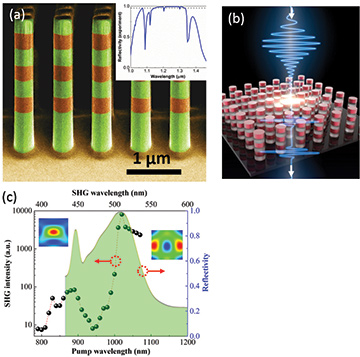 (a) False-color SEM image of multilayer GaAs dielectric metamaterials. Inset: reflectivity spectra of the sample exhibiting approximately 100 percent reflectivity. (b) Schematic of a multilayer metamaterial designed to recompress femtosecond optical pulses. (c) Resonantly enhanced second-harmonic generation from GaAs dielectric metamaterials.
(a) False-color SEM image of multilayer GaAs dielectric metamaterials. Inset: reflectivity spectra of the sample exhibiting approximately 100 percent reflectivity. (b) Schematic of a multilayer metamaterial designed to recompress femtosecond optical pulses. (c) Resonantly enhanced second-harmonic generation from GaAs dielectric metamaterials.
All-dielectric metamaterials consist of arrays of high-index, subwavelength-size Mie resonators that enable manipulation of the electromagnetic permittivity and permeability, but with much lower loss at optical frequencies than their metallic metamaterial counterparts. Recent examples have shown impressive performance in nonlinear optical conversion, spectral filtering and advanced wavefront engineering1,2. Most efforts at wavelengths shorter than the mid-infrared, however, have employed silicon, which lacks second-order optical nonlinearities and is not an efficient light emitter.
Recently, our group proposed a new class of dielectric metamaterials based upon III–V semiconductors that exhibit strong intrinsic optical nonlinearities and allow for full integration with optoelectronic functionality. We achieve high refractive-index contrast between the resonators and their surrounding environments by selectively oxidizing semiconductors to their native oxides. This simplifies fabrication and guarantees strong electromagnetic-field confinement and mode control.
We experimentally demonstrated GaAs/AlGaAs-based dielectric metamaterials possessing magnetic and electric dipole resonances that are widely tunable across the near-infrared spectral region.3 Our top-down fabrication process also enables more complicated architectures, such as multilayer dielectric metamaterials, which provide new degrees of freedom in device engineering.
For example, we showed that our structures can be designed to act as broadband mirrors of nearly 100 percent reflectivity, outperforming even gold mirrors. We also showed numerically that our structures can be used as high-efficiency, ultrathin dispersion compensators to recompress femtosecond optical pulses that were broadened by passing through dispersive media. Extension of this dielectric metamaterial fabrication strategy could lead to fully 3-D, low-loss metamaterials at visible wavelengths—overcoming a long-standing challenge in metamaterial research.
Efficient nonlinear optical conversion using ultracompact nanostructured materials also shows enormous potential for demanding applications such as bioimaging and sensing. Using III–V dielectric metasurfaces, we observed strong resonantly enhanced second-harmonic generation with conversion efficiencies exceeding 10–5, several orders of magnitude higher than with metallic metasurfaces.4,5 We expect to obtain much higher conversion efficiencies by operating at longer wavelengths to reduce optical absorption, and by optimizing the modal overlap between the second-harmonic and fundamental wavelengths.
These III–V dielectric metamaterials, we believe, could enable extremely compact optical components, significantly lowering manufacturing costs, size and energy consumption. Furthermore, integrating gain media with these metamaterials can significantly improve the quantum efficiency and photon generation rate for quantum emitters, potentially allowing development of novel detectors and modulators.
Researchers
Sheng Liu, Michael B. Sinclair, Gordon A. Keeler, John L. Reno and Igal Brener, Sandia National Laboratories, Albuquerque, N.M., USA
References
1. S. Liu et al. Optica 1, 250 (2014).
2. S. Jahani et al. Nat. Nanotech. 11, 23 (2016).
3. S. Liu et al. Adv. Opt. Mater. 4, 1457 (2016).
4. S. Liu et al. Nano Lett. 16, 5426 (2016).
5. V.F. Gili et al. Opt. Express 24, 15965 (2016)
